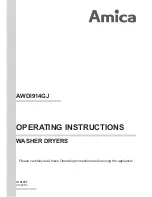
13
Install Vent System
12" min.
(305 mm)
12" min.
(305 mm)
1.
Install exhaust hood
Install exhaust hood and use caulking compound to seal
exterior wall opening around exhaust hood.
A
B
C
D
2.
Plan pipe fitting connection
A combination of pipe fittings must be used to connect dryer
to existing gas line. A recommended connection is shown.
Your connection may be different, according to supply line
type, size, and location.
A.
9.5 mm (3/8") flexible gas
connector
B.
9.5 mm (3/8") dryer pipe
C.
9.5 mm (3/8") to
9.5 mm (
3/8")
pipe elbow
D.
9.5 mm (3/8") pipe-to-flare
adapter fitting
Open shut-off valve in supply line; valve is open when handle
is parallel to gas pipe. Then, test all connections by brushing
on an approved noncorrosive leak-detection solution.
Bubbles will show a leak. Correct any leaks found.
2.
Connect vent to exhaust hood
Vent must fit over the exhaust hood. Secure vent to exhaust
hood with 102 mm (4") clamp. Run vent to dryer location
using straightest path possible. Avoid 90° turns. Use clamps
to seal all joints. Do not use duct tape, screws, or other
fastening devices that extend into interior of vent to secure
vent, because they can catch lint.
A
B
1.
Connect gas supply to dryer
Remove red cap from gas pipe. Using a wrench to tighten,
connect gas supply to dryer. Use pipe-joint compound
on threads of all non-flared male fittings. If flexible metal
tubing is used, be sure there are no kinks.
NOTE:
For LP gas connections, you must use pipe-joint
compound resistant to action of LP gas. Do not use
TEFLON
®
tape.
MAKE GAS CONNECTION
3.
Open shut-off valve
A
B
Closed valve
Open valve
Non-flared
male fitting
Flared
male fitting
305 mm min.
(12" min.)
305 mm min.
(12" min.)
Vent System Chart
(Long Vent Models Only)
Number of
90° turns
or elbows
Type
of vent
Box/louvered,
or Angled hoods
0
Rigid metal
36.6 m (120 ft.)
1
Rigid metal
33.5 m (110 ft.)
2
Rigid metal
30.5 m (100 ft.)
3
Rigid metal
27.4 m. (90 ft)
4
Rigid metal
24.4 m. (80 ft)
5
Rigid metal
21.3 m (70 ft.)




































